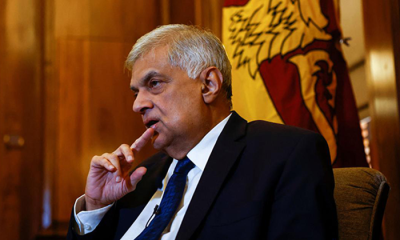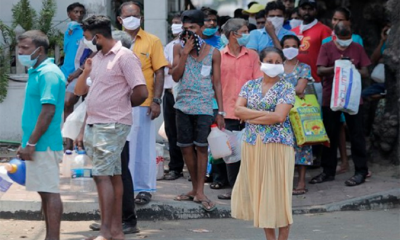Features
Fiscal decentralisation key to balanced growth

By SANCHARI MUKHOPADHYAY
Urbanisation in India is progressing at an unprecedented pace, creating an urgent need to address the challenges that accompany it. The cities are growing, infrastructure is inadequate, and public services are under immense stress. At the heart of these challenges lies an elite-influenced urban growth pattern, represented by the disproportionate expansion of larger cities compared to the small cities and towns.
This also leads to over-congestion and strained resources for overall urban development. Addressing this issue necessitates a closer look at our urban development strategies, with a particular focus on small and medium towns and cities wherein fiscal decentralisation is also significant. Here, it is important to shed light on the imperative of recalibrating our approach to urban development, emphasising the potential of smaller urban centres in fostering balanced growth and sustainable futures.
The current urban landscape is of stark imbalance. Larger cities, home to millions, are growing at an exponential rate, attracting a huge pool of poor migrants in search of better economic opportunities. For the past few decades, the population in class I cities has been consistently increasing, intensifying the pressure on these urban agglomerations. On the flip side, smaller towns, and cities, despite housing nearly 43 per cent of the urban population, remain underlooked in terms of investment and development.
This top-heavy growth pattern not only misses the challenges faced by larger cities but also limits the potential for small and medium size urban centres to contribute to the country’s economic growth and sustainability. Fiscal decentralisation stands out as a crucial strategy in addressing the challenges posed by rapid urbanisation. At its core, fiscal decentralisation empowers local governments with the authority and resources to make decisions and raise revenue locally.
Transferring financial powers, functions, and resources from the central and state government to the local bodies can empower small and medium sized towns and cities, enable them to attract greater investment, create jobs, and support balanced regional growth. This can further allow smaller urban units to address their specific needs and experiment with innovative approaches and solutions tailored to their priorities.
The shift is vital in alleviating the mounting pressure on larger cities, and ensuring sustainable urban development even outside them. However, the journey towards effective fiscal decentralisation is riddled with challenges. Smaller towns and cities often suffer from limited financial autonomy, outdated revenue-generating mechanisms, and a lack of administrative as well as human capacities.
A report by the World Bank in 2019 highlighted that many small and medium-sized urban centres in India face issues related to inadequate service delivery, and infrastructural deficit. For instance, property tax, which is a significant source of revenue for local bodies, is underutilised in smaller towns, contributing to just 0.2 per cent of India’s GDP, compared to the global average of around 0.6 per cent. Furthermore, these urban centres often have limited access to capital markets, which restricts their ability to raise funds independently.
A multi-faceted strategy is essential to overcome these challenges. It is also to be noted that while GST is collected across the country, the share of the same is going only to two of the tiers of government, leaving out all local bodies from this revenue stream. Investing in infrastructure and service delivery emerges as a primary area of focus. Small and medium towns and cities require substantial financial support to enhance their quality of life and economic vitality.
This is where fiscal decentralisation steps in, ensuring that these towns and cities receive adequate financial support from higher levels of government. Revising tax systems, exploring alternative financing options, and investing in capacity-building initiatives and institutions are crucial steps in this direction. Additionally, promoting transparency and accountability in fiscal management is imperative.
Implementing robust financial management systems, conducting regular audits, and engaging citizens in the decision making and accountability process can ensure that funds are utilised effectively, fostering trust and participation among the local population. The central and state governments have to play a pivotal role in driving fiscal decentralisation, acting as regulators and facilitators. Providing the necessary policy framework, legal support, and financial assistance and provisions for adequate human resources are vital to empower local bodies to take charge of their development trajectories.
Engaging the private sector through private-public partnerships, particularly in a subsidised model, can also help bridge funding gaps and spur economic growth in smaller urban centres. Leveraging private investment in a respected as well as a regulated manner will not only enhance the financial capabilities of these towns and cities but also drive innovation and efficiency in public service delivery, although an additional task of minimising the conflict of interest arises here. As we observed World Cities Day on October 31, with a focus on ‘financing a sustainable urban future for all’, it becomes imperative to reflect on our urban development strategies.
This emphasis aligns seamlessly with the aspiration of achieving Sustainable Development Goals having a particular focus on inclusivity and matches well with the recent attention on ‘financing the cities of tomorrow’ during the recent G20 summit held in the country. Fiscal decentralisation, combined with systematic urban planning focusing on neglected urban settings, appears central to achieving inclusive and sustainable urban growth.
Engaging all stakeholders, from government bodies to local communities, in the urban development process is crucial for fostering collaborative and effective city management and planning. Fiscal decentralisation as told earlier, emerges as a critical tool in addressing the challenges of rapid urbanisation in India. It is not just a technical policy term but represents a transformative force that can directly impact the capacity of these neglected urban areas to gain prosperity.
By providing them with the necessary resources and autonomy, fiscal decentralisation can empower these towns and cities to become self-reliant contributors to regional development, and tap into their economic potential. While finding the right balance between the central and local control remains a complex task, the time to act is now, and a collaborative, transparent, and inclusive approach stands as the key to unlocking a sustainable urban future for India.
(TheStatesman/ANN)
(The writer is Policy Analyst, Centre for Budget and Governance Accountability, New Delhi. The views expressed are personal.)
Features
RIDDHI-MA:

A new Era of Dance in Sri Lanka
Kapila Palihawadana, an internationally renowned dancer and choreographer staged his new dance production, Riddhi-Ma, on 28 March 2025 at the Elphinstone theatre, which was filled with Sri Lankan theatregoers, foreign diplomats and students of dance. Kapila appeared on stage with his charismatic persona signifying the performance to be unravelled on stage. I was anxiously waiting to see nATANDA dancers. He briefly introduced the narrative and the thematic background to the production to be witnessed. According to him, Kapila has been inspired by the Sri Lankan southern traditional dance (Low Country) and the mythologies related to Riddhi Yâgaya (Riddi Ritual) and the black magic to produce a ‘contemporary ballet’.
Riddhi Yâgaya also known as Rata Yakuma is one of the elaborative exorcism rituals performed in the southern dance tradition in Sri Lanka. It is particularly performed in Matara and Bentara areas where this ritual is performed in order to curb the barrenness and the expectation of fertility for young women (Fargnoli & Seneviratne 2021). Kapila’s contemporary ballet production had intermingled both character, Riddi Bisaw (Princes Riddhi) and the story of Kalu Kumaraya (Black Prince), who possesses young women and caught in the evil gaze (yaksa disti) while cursing upon them to be ill (De Munck, 1990).
Kapila weaves a tapestry of ritual dance elements with the ballet movements to create visually stunning images on stage. Over one and a half hours of duration, Kapila’s dancers mesmerized the audience through their virtuosic bodily competencies in Western ballet, Sri Lankan dance, especially the symbolic elements of low country dance and the spontaneity of movements. It is human bodily virtuosity and the rhythmic structures, which galvanised our senses throughout the performance. From very low phases of bodily movements to high speed acceleration, Kapila managed to visualise the human body as an elevated sublimity.
Contemporary Ballet

Figure 2 – (L) Umesha Kapilarathna performs en pointe, and (R) Narmada Nekethani performs with Jeewaka Randeepa, Riddhi-Ma, at Elphinstone Theatre, Maradana, 28th March 2025. Source:
Malshan Witharana
The dance production Riddhi-Ma was choreographed in several segments accompanied by a flow of various music arrangements and sound elements within which the dance narrative was laid through. In other words, Kapila as a choreographer, overcomes the modernist deadlock in his contemporary dance work that the majority of Sri Lankan dance choreographers have very often succumbed to. These images of bodies of female dancers commensurate the narrative of women’s fate and her vulnerability in being possessed by the Black Demon and how she overcomes and emancipates from the oppression. In this sense, Kapila’s dancers have showcased their ability to use the bodies not much as an object which is trained to perform a particular tradition but to present bodily fluidity which can be transformed into any form. Kapila’s performers possess formlessness, fluid fragility through which they break and overcome their bodily regimentations.
It was such a highly sophisticated ‘contemporary ballet’ performed at a Sri Lankan theatre with utmost rigour and precision. Bodies of all male and female dancers were highly trained and refined through classical ballet and contemporary dance. In addition, they demonstrated their abilities in performing other forms of dance. Their bodies were trained to achieve skilful execution of complex ballet movements, especially key elements of traditional ballet namely, improvisation, partnering, interpretation and off-balance and the local dance repertoires. Yet, these key ballet elements are not necessarily a part of contemporary ballet training (Marttinen, 2016). However, it is important for the dance students to learn these key elements of traditional ballet and use them in the contemporary dance settings. In this sense, Kapila’s dancers have achieved such vigour and somatic precision through assiduous practice of the body to create the magic on stage.
Pas de deux

Among others, a particular dance sequence attracted my attention the most. In the traditional ballet lexicon, it is a ‘pas de deux’ which is performed by the ‘same race male and female dancers,’ which can be called ‘a duet’. As Lutts argues, ‘Many contemporary choreographers are challenging social structures and norms within ballet by messing with the structure of the pas de deux (Lutts, 2019). Pas de Deux is a dance typically done by male and female dancers. In this case, Kapila has selected a male and a female dancer whose gender hierarchies appeared to be diminished through the choreographic work. In the traditional pas de deux, the male appears as the backdrop of the female dancer or the main anchorage of the female body, where the female body is presented with the support of the male body. Kapila has consciously been able to change this hierarchical division between the traditional ballet and the contemporary dance by presenting the female dominance in the act of dance.
The sequence was choreographed around a powerful depiction of the possession of the Gara Yakâ over a young woman, whose vulnerability and the powerful resurrection from the possession was performed by two young dancers. The female dancer, a ballerina, was in a leotard and a tight while wearing a pair of pointe shoes (toe shoes). Pointe shoes help the dancers to swirl on one spot (fouettés), on the pointed toes of one leg, which is the indication of the ballet dancer’s ability to perform en pointe (The Kennedy Centre 2020).
The stunning imagery was created throughout this sequence by the female and the male dancers intertwining their flexible bodies upon each other, throwing their bodies vertically and horizontally while maintaining balance and imbalance together. The ballerina’s right leg is bent and her toes are directed towards the floor while performing the en pointe with her ankle. Throughout the sequence she holds the Gara Yakâ mask while performing with the partner.
The male dancer behind the ballerina maintains a posture while depicting low country hand gestures combining and blurring the boundaries between Sri Lankan dance and the Western ballet (see figure 3). In this sequence, the male dancer maintains the balance of the body while lifting the female dancer’s body in the air signifying some classical elements of ballet.
Haptic sense

Figure 3: Narmada Nekathani performs with the Gara Yaka mask while indicating her right leg as en pointe. Male dancer, Jeewaka Randeepa’s hand gestures signify the low country pose. Riddhi-Ma, Dance Theatre at Elphinstone Theatre, 28th March 2025. Source: Malshan Witharana.
One significant element of this contemporary ballet production is the costume design. The selection of colour palette, containing black, red and while combining with other corresponding colours and also the costumes which break the traditional rules and norms are compelling. I have discussed in a recent publication how clothes connect with the performer’s body and operate as an embodied haptic perception to connect with the spectators (Liyanage, 2025). In this production, the costumes operate in two different ways: First it signifies sculpted bodies creating an embodied, empathic experience.
Secondly, designs of costumes work as a mode of three dimensional haptic sense. Kapila gives his dancers fully covered clothing, while they generate classical ballet and Sinhalese ritual dance movements. The covered bodies create another dimension to clothing over bodies. In doing so, Kapila attempts to create sculpted bodies on stage by blurring the boundaries of gender oriented clothing and its usage in Sri Lankan dance.
Sri Lankan female body on stage, particularly in dance has been presented as an object of male desire. I have elsewhere cited that the lâsya or the feminine gestures of the dance repertoire has been the marker of the quality of dance against the tândava tradition (Liyanage, 2025). The theatregoers visit the theatre to appreciate the lâsya bodies of female dancers and if the dancer meets this threshold, then she becomes the versatile dancer. Kandyan dancers such as Vajira and Chithrasena’s dance works are explored and analysed with this lâsya and tândava criteria. Vajira for instance becomes the icon of the lâsya in the Kandyan tradition. It is not my intention here to further discuss the discourse of lâsya and tândava here.
But Kapila’s contemporary ballet overcomes this duality of male-female aesthetic categorization of lâsya and tândava which has been a historical categorization of dance bodies in Sri Lanka (Sanjeewa 2021).

Figure 4: Riddhi-Ma’s costumes creates sculpted bodies combining the performer and the audience through empathic projection. Dancers, Sithija Sithimina and Senuri Nimsara appear in Riddhi-Ma, at Elphinstone Theatre, 28th March 2025, Source, Malshan Witharana.
Conclusion
Dance imagination in the Sri Lankan creative industry exploits the female body as an object. The colonial mind set of the dance body as a histrionic, gendered, exotic and aesthetic object is still embedded in the majority of dance productions produced in the current cultural industry. Moreover, dance is still understood as a ‘language’ similar to music where the narratives are shared in symbolic movements. Yet, Kapila has shown us that dance exists beyond language or lingual structures where it creates humans to experience alternative existence and expression. In this sense, dance is intrinsically a mode of ‘being’, a kinaesthetic connection where its phenomenality operates beyond the rationality of our daily life.
At this juncture, Kapila and his dance ensemble have marked a significant milestone by eradicating the archetypical and stereotypes in Sri Lankan dance. Kapila’s intervention with Riddi Ma is way ahead of our contemporary reality of Sri Lankan dance which will undoubtedly lead to a new era of dance theatre in Sri Lanka.
References
De Munck, V. C. (1990). Choosing metaphor. A case study of Sri Lankan exorcism. Anthropos, 317-328. Fargnoli, A., & Seneviratne, D. (2021). Exploring Rata Yakuma: Weaving dance/movement therapy and a
Sri Lankan healing ritual. Creative Arts in Education and Therapy (CAET), 230-244.
Liyanage, S. 2025. “Arts and Culture in the Post-War Sri Lanka: Body as Protest in Post-Political Aragalaya (Porattam).” In Reflections on the Continuing Crises of Post-War Sri Lanka, edited by Gamini Keerawella and Amal Jayawardane, 245–78. Colombo: Institute for International Studies (IIS) Sri Lanka.
Lutts, A. (2019). Storytelling in Contemporary Ballet.
Samarasinghe, S. G. (1977). A Methodology for the Collection of the Sinhala Ritual. Asian Folklore Studies, 105-130.
Sanjeewa, W. (2021). Historical Perspective of Gender Typed Participation in the Performing Arts in Sri Lanka During the Pre-Colonial, The Colonial Era, and the Post-Colonial Eras. International Journal of Social Science And Human Research, 4(5), 989-997.
The Kennedy Centre. 2020. “Pointe Shoes Dancing on the Tips of the Toes.” Kennedy-Center.org. 2020 https://www.kennedy-center.org/education/resources-for-educators/classroom-resources/media- and-interactives/media/dance/pointe-shoes/..
Acknowledgements
The author wishes to thank Himansi Dehigama for proofreading this article.
About the author:
Saumya Liyanage (PhD) is a film and theatre actor and professor in drama and theatre, currently working at the Department of Theatre Ballet and Modern Dance, Faculty of Dance and Drama, University of the Visual and Performing Arts (UVPA), Colombo. He is the former Dean of the Faculty of Graduate Studies and is currently holding the director position of the Social Reconciliation Centre, UVPA Colombo.
Features
Sri Lanka’s Foreign Policy amid Geopolitical Transformations: 1990-2024 – Part II

Chinese Naval Entry and End of Post-War Unipolarity
The ascendancy of China as an emerging superpower is one of the most striking shifts in the global distribution of economic and political power in the 21st century. With its strategic rise, China has assumed a more proactive diplomatic and economic role in the Indian Ocean, signalling its emergence as a global superpower. This new leadership role is exemplified by initiatives such as the Belt and Road Initiative (BRI) and the establishment of the Asian Infrastructure Investment Bank (AIIB). The Economist noted that “China’s decision to fund a new multilateral bank rather than give more to existing ones reflects its exasperation with the glacial pace of global economic governance reform” (The Economist, 11 November 2014). Thus far, China’s ascent to global superpower status has been largely peaceful.
In 2025, in terms of Navy fleet strength, China became the world’s largest Navy, with a fleet of 754 ships, thanks to its ambitious naval modernisation programme. In May 2024, the People’s Liberation Army Navy (PLAN) further strengthened its capabilities by commissioning the Fujian, its latest aircraft carrier. Equipped with an advanced electromagnetic catapult system, the Fujian can launch larger and heavier aircraft, marking a significant upgrade over its predecessors.
Driven by export-led growth, China sought to reinvest its trade surplus, redefining the Indian Ocean region not just as a market but as a key hub for infrastructure investment. Notably, over 80 percent of China’s oil imports from the Persian Gulf transit to the Straits of Malacca before reaching its industrial centres. These factors underscore the Indian Ocean’s critical role in China’s economic and naval strategic trajectories.
China’s port construction projects along the Indian Ocean littoral, often associated with the Belt and Road Initiative (BRI), exemplify its deepening geopolitical and economic engagement in the region. These initiatives encompass multipurpose berth development, deep-sea port construction, and supporting infrastructure projects aimed at enhancing maritime connectivity and trade. Key projects include the development of Gwadar Port in Pakistan, a strategic asset for China’s access to the Arabian Sea; Hambantota Port in Sri Lanka, which became a focal point of debt diplomacy concerns; the Payra deep-sea port in Bangladesh; as well as port and road infrastructure development in Myanmar’s Yunnan and Kyaukphyu regions and Cambodia’s Koh Kong.
While these projects were promoted as avenues for economic growth and regional connectivity, they also triggered geopolitical tensions and domestic opposition in several host countries. Concerns over excessive debt burdens, lack of transparency, and potential dual-use (civilian and military) implications of port facilities led to scrutiny from both local and external stakeholders, including India and Western powers. As a result, some projects faced significant pushback, delays, and, in certain cases, suspension or cancellation. This opposition underscores the complex interplay between economic cooperation, strategic interests, and sovereignty concerns in China’s Indian Ocean engagements.
China’s expanding economic, diplomatic, and naval footprint in the Indian Ocean has fundamentally altered the region’s strategic landscape, signalling the end of early post-Cold War unipolarity. Through the Belt and Road Initiative (BRI) initiatives, China has entrenched itself economically, financing. Diplomatically, Beijing has deepened its engagement with littoral states through bilateral agreements, security partnerships, and regional forums, challenging traditional Western and Indian influence.
China’s expanding naval deployments in the Indian Ocean, including its military base in Djibouti, and growing security cooperation with regional states, mark the end of unchallenged US dominance in the region. The Indian Ocean is now a contested space, where China’s presence compels strategic recalibrations by India, the United States, and other regional actors. The evolving security landscape in the Indian Ocean—marked by intensifying competition, shifting alliances, and the rise of a multipolar order—has significant implications for Sri Lanka’s geopolitical future.
India views China’s growing economic, political, and strategic presence in the Indian Ocean region as a key strategic challenge. In response, India has pursued a range of strategic, political, and economic measures to counterbalance Chinese influence, particularly in countries like Sri Lanka through infrastructure investment, defense partnerships, and diplomatic engagements.
Other Extra-Regional powers
Japan and Australia have emerged as significant players in the post-Cold War strategic landscape of the Indian Ocean. During the early phases of the Cold War, Australia played a crucial role in Western ‘Collective Security Alliances’ (ANZUS and (SEATO). However, its direct engagement in Indian Ocean security remained limited, primarily supporting the British Royal Navy under Commonwealth obligations. Japan, meanwhile, refrained from deploying naval forces in the region after World War II, adhering to its pacifist constitution and post-war security policies. In recent decades, shifting strategic conditions have prompted both Japan and Australia to reassess their roles in the Indian Ocean, leading to greater defence cooperation and a more proactive regional presence.
In the post-Cold War era, Australia has progressively expanded its naval engagements in the Indian Ocean, driven by concerns over maritime security, protection of trade routes, and China’s growing influence. Through initiatives, such as the Quadrilateral Security Dialogue (Quad) and deeper defence partnerships with India and the United States, Australia has bolstered its strategic presence in the Indian Ocean region.
Recalibration of Japan’s approach
Japan, too, has recalibrated its approach to Indian Ocean security in response to geopolitical shifts. Recognising the Indian Ocean’s critical importance for its energy security and trade, Japan has strengthened its naval presence through port visits, joint exercises, and maritime security cooperation. The Japan Maritime Self-Defence Force (JMSDF) has taken on a more active role in anti-piracy operations, freedom of navigation operations (FONOPS), and strategic partnerships with Indian Ocean littoral states. This shift aligns with Japan’s broader strategy of contributing to regional stability while balancing its constitutional constraints on military force projection.
Japan’s proactive role in the Indian Ocean region is evident in its diplomatic and defence engagements. In January 2019, Japan sent its Foreign Minister, Taro Kono, and Chief of Staff, Joint Staff, Katsutoshi Kawano, to the Raisina Dialogue, a high-profile geopolitical conference in India. Japan’s National Security Strategy, released in December 2022, identifies China’s growing assertiveness as its greatest strategic challenge and underscores the need to deepen bilateral ties and multilateral defence cooperation in the Indian Ocean. It also emphasises the importance of securing stable access to sea-lanes, through which more than 80 percent of Japan’s oil imports pass. In recent years, Japan has expanded its port investment portfolio across the Indian Ocean, with major projects in Sri Lanka, Bangladesh, and Myanmar. In 2021, Japan participated for the first time in CARAT-Sri Lanka (Cooperation Afloat Readiness and Training), a bilateral naval exercise. Japan’s Maritime Self-Defence Force returned for the exercise in January 2023, held at Trincomalee Port and Mullikulam Base.
Japan’s strategic interests in the Indian Ocean have been most evident in its involvement in port infrastructure development projects. Sri Lanka, Bangladesh, and Myanmar are key countries where early Chinese-led port construction faced setbacks. Unlike India, which carries historical and political complexities in its relations with these countries, Japan is better positioned to compete with China. In December 2021, a Japanese company established a ship repair and rebuilding facility in Trincomalee, complementing the already well-established Tokyo Cement factory. When the Sri Lanka Ports Authority announced plans in mid-2022 to develop Trincomalee as an industrial port—inviting expressions of interest from investors to utilise port facilities and up to 2,400 hectares of surrounding land—Trincomalee regained strategic attention.
The Colombo Dockyard, in collaboration with Japan’s Onomichi Dockyard, has established a rapid response afloat service in Trincomalee, marking a significant development in Japan’s engagement with Sri Lanka’s maritime infrastructure. This initiative aligns with Japan’s broader strategic interests in the Bay of Bengal, a region of critical economic and security importance. A key Japanese concern appears to be limiting China’s ability to establish a permanent presence in Trincomalee. This initiative underscores the broader strategic competition in the Indian Ocean. Trincomalee, with its deep-water harbour, has long been regarded as a critical maritime asset. Japan’s involvement reflects its efforts to deepen economic and strategic engagement with Sri Lanka amid growing regional competition. The challenge before Sri Lanka is how to navigate this strategic contest while maximising its national interests.
Other Regional Powers
In analyzing the evolving naval security architecture of the post-Cold War Indian Ocean, particular attention should be given to the naval developments of regional powers such as Pakistan, Indonesia, and Malaysia. In 2012, Pakistan established the Naval Strategic Force Command (NSFC) to strengthen Pakistan’s policy of Credible Minimum Deterrence (CMD). The creation of the NSFC suggests a shift toward sea-based deterrence, complementing Pakistan’s broader military strategy. In December 2012, Pakistan conducted a series of cruise missile tests from naval platforms in the Arabian Sea. Given India’s expanding maritime capabilities, which Pakistan views as a significant threat, the Pakistan Navy may consider deploying tactical nuclear weapons on surface ships as part of its evolving deterrence strategy. Sri Lanka’s foreign policy cannot overlook this development.
Indonesia also emerged as a significant player in the evolving naval security landscape of the Indian Ocean. In 2010, it launched a military modernisation programme aimed at achieving a ‘Minimum Essential Force’ (MEF) by 2024. As part of this initiative, Indonesia sought to build a modern Navy with 247 surface vessels and 12 submarines. One of the primary challenges faced by the Indonesian Navy (TNI-AL) is piracy. To enhance maritime security, Indonesia and Singapore signed the SURPIC Cooperation Arrangement in Bantam in May 2005, enabling real-time sea surveillance in the Singapore Strait for more effective naval patrols. In 2017, Indonesia introduced the Indonesian Ocean Policy (IOP) and subsequently incorporated blue economy strategies into its national development agenda, reinforcing its maritime vision. According to projections from the Global Firepower Index, published in 2025, the Indonesian Navy is ranked fourth in global ranking and second in Asia in terms of Navy fleet strength (Global Firepower, 2025).
In October 2012, the Royal Malaysian Navy (RMN) announced plans to build a second Scorpène simulator training facility at its base in Kota Kinabalu, in addition to submarine base in Sepanggar, Sabah, constructed in 2002. To enhance its naval capabilities, the RMN planned to procure 18 Littoral Mission Ships (LMS) for maritime surveillance and six Littoral Combat Ships (LCS) between 2019 and 2023. Malaysia and China finalised their first major defence deal during Prime Minister Najib Razak’s visit to Beijing in November 2016. During this visit, Malaysia’s Defence Ministry signed a contract to procure LMS from China, as reported by The Guardian. Despite this agreement, Malaysia continues to maintain amicable relations with both China and India, as does Indonesia.
The increasing presence of major naval powers, the rise of regional stakeholders, and the growing significance of trade routes and maritime security have transformed the Indian Ocean into a central pivot of both regional and global politics, with Sri Lanka positioned at its heart. (To be Continued)
by Gamini Keerawella
Features
More excitement for Andrea Marr…

Sri Lankan Andrea Marr, now based in Australia, is in the spotlight again. She says she has teamed up with a fantastic bunch of Sri Lankan musicians, in Melbourne, and the band is called IntoGroove.
“The band has been going strong for many years and I have been a fan of this outfit for quite a few years; just love these guys, authentic R&B and funk.”
Although Andrea has her original blues band, The McNaMarr Project, and they do have a busy schedule, she went on to say that “when the opportunity came up to join these guys, I simply couldn’t refuse … they are too good.”
IntoGroove is Jude Nicholas (lead vocals), Peter Menezes (bass), Keith Pereira (drums), Blaise De Silva (keyboards) and and Steve Wright (guitar).

Andrea Marr: Powerhouse of the blues
“These guys are a fantastic band and I really want everyone to hear them.”
Andrea is a very talented artiste with many achievements to her credit, and a vocal coach, as well.
In fact, she did her second vocal coaching session at Australian Songwriters Conference early this year.
Her first student showcase for this year took place last Sunday, in Melbourne, and it brought into the spotlight the wonderful acts she has moulded, as teacher and mentor.
What makes Andrea extra special is that she has years of teaching experience and is able to do group vocal coaching for all styles, levels and genres.
In January, this year, she performed at the exclusive ‘Women In Blues’ showcase at Alfred’s On Beale Street (rock venue with live entertainment), in Memphis, in the USA, during the International Blues Challenge when bands from all over the world converge on Memphis for the ‘Olympics of the Blues.’

The McNaMarr Project with Andrea and Lindsay Marr in the
vocal spotlight
This was her fourth performance in the home of the blues; she has represented Australian Blues three times and, on this occasion, she went as ambassador for Blues Music Victoria, and The Melbourne Blues Appreciation Society’s ‘Women In Blues’ Coordinator.
Andrea was inducted into the Blues Music Victoria Hall of Fame in 2022 and released her 10th album which hit #1 on the Australian Blues Charts.
Known as ‘the pint-sized powerhouse of the blues’ for her high energy, soulful, original music, Andrea is also a huge fan of the late Elvis Presley and has checked out Graceland, in Memphis, Tennessee, USA, many times.
In Melbourne, the singer also plays a major role in helping Animal Rescue organisations find homes for abandoned cats.
Andrea Marr’s wish, at the moment, is that the Lankan audience, in Melbourne, would get behind this band, IntoGroove. They are world class, she added.
-

 Business2 days ago
Business2 days agoColombo Coffee wins coveted management awards
-

 Features3 days ago
Features3 days agoStarlink in the Global South
-

 Business4 days ago
Business4 days agoDaraz Sri Lanka ushers in the New Year with 4.4 Avurudu Wasi Pro Max – Sri Lanka’s biggest online Avurudu sale
-

 Business5 days ago
Business5 days agoStrengthening SDG integration into provincial planning and development process
-

 Business4 days ago
Business4 days agoNew SL Sovereign Bonds win foreign investor confidence
-

 Sports6 days ago
Sports6 days agoTo play or not to play is Richmond’s decision
-

 Features3 days ago
Features3 days agoModi’s Sri Lanka Sojourn
-

 Sports5 days ago
Sports5 days agoNew Zealand under 85kg rugby team set for historic tour of Sri Lanka





















